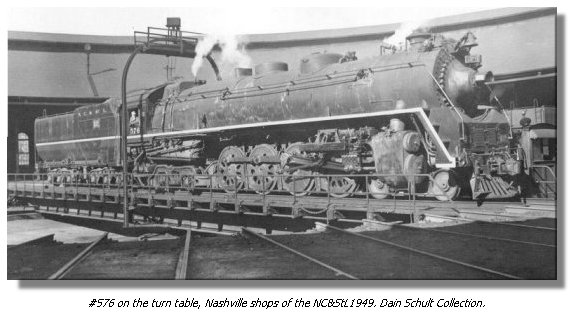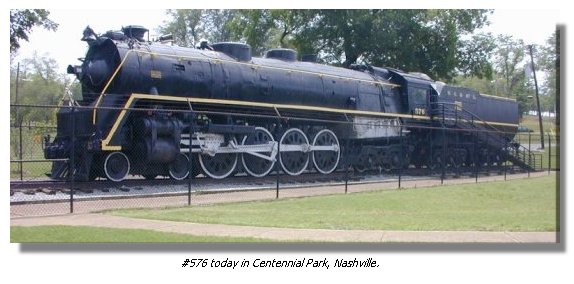
|
|
|
Engine # 576 was built by the American Locomotive Company in August 1942, a class J-3, builder #69786. Designed by C.M. Darden, the NC's Chief Mechanical Officer, The J3's were a technological marvel marvel of their day. The one piece cast frame and sealed roller bearings on the engine were revolutionary in reducing maintenance costs for the road. And the lateral motion devices on the lead driver set allowed a much larger, and more powerful, engine to be used on the NC's tight curves. |
|
|
The Whyte system classification for steam engines calls #576 a 4-8-4. Four wheels on the leading trucks, eight drivers, and four wheels on the trailing truck. Most railroads called their 4-8-4s "Northerns" after the Northern Pacific Railroad, who first adopted the design. However, the NC&StL went to and from Dixieland, so no "Northerns" would be welcome on the line. Instead, the 4-8-4s were called "Dixies." In practice, the crews called the engines "Yellow Jackets" or "Stripes." As delivered, the 576 had a streamlined nose and wide skirts. However, during the Second World War, shop crews cut off the streamlining to make servicing the engine faster and easier When the engines were streamlined, the crews called them "Yellow Jackets" for the broad yellow stripe on their sides. When the wide stripe was removed after the skirts were gone, they were called "Stripes" for the thin line of paint that replaced the wide stripe. After the traffic surge died down from the Second World War, and traffic died down, the J3's were bumped from prime service spots to lesser passenger and freight trains. Eventually, by September 2 1952, all of the J3's were withdrawn from service. All of them except #576 were scrapped. The only surviving example of mainline NC&StL steam, J3-57 class locomotive #576 has been on static display in Centennial Park,
Restoration of 576 is in the works! See Nashville Steam Preservation Society |
NC&StL Preservation Society, Inc. is in no way
affiliated with the NC&StL Railway or any of it's successors.
As a non-profit entity, NCPS presents these pages to the public purely
for educational and historic interest.
Return
to top
| Home | About
Us | History | Engine
576 | Cities | People
| Model
Railroading
Membership | Merchandise
| Links | Site
Map | Contact Us | Copyright | Privacy
Policy
We can't do it without your help!
If you have information
you would like to contribute,
we would appreciate
hearing from you.
(c) 2003, NC&StL Preservation Society

